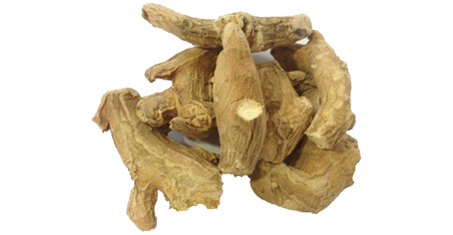What Is Dried Ginger?

The botanical name for dried ginger is Zingiber Officinale {Rhizomes} while the local names for the product in Nigeria include Chitta {Hausa} ,Oso- ala or Oso - Chikwu {Igbo} and Ata'le {Yoruba}. All harvested rhizomes are washed (and possibly soaked overnight) to remove any attached soil and then dried.
Dried Ginger Plant and Cultivation
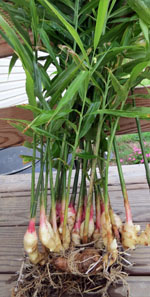
The climatic and soil conditions in Nigeria supports the cultivation and rearing of different crops and animals respectively and ginger is one of the products grown in abundant quantity.
Ginger is an important spice crop widely grown in Nigeria. Harvesting of ginger starts from October and normally continues until April/May. This largely depends on the market situation as ginger can be left on the ground (not harvested) for two years. The fresh ginger refers to the newly harvested ginger with little or no lost in moisture content. This type of ginger is not in hot demand in the international market because of the length of time it takes for the product to dry up and use in production. Dry whole and dry split ginger are the most sorted after gingers in the international market with whole dry ginger commanding higher price because of the longer time it takes for the product to get dry and ready for sales. The type of ginger grown in Nigeria is the yellow tye which possesses harsh pungent and very strong odour.
Dried Ginger Description
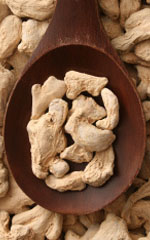
Ginger is a spice of commercial and medicinal importance. Sun drying of ginger rhizome retains its colour and aroma than mechanical drying of ginger rhizome using hot air dryer, but hot air dryer dries ginger rhizome faster than sun drying of ginger rhizome. Peeled or scraped rhizome reduces drying time, thus minimizing mold growth and fermentation. However, while this process decreases the fiber content by removing the outside corky skin, it also tends to remove some of the oils constituents, as they are more concentrated in the peel, and therefore reduces some of the pungency. Splited or sliced ginger rhizome dries faster than peeled ginger rhizome under the same conditions. Mechanical drying of ginger gives a more homogenous and cleaner product than sun drying of ginger. Traditional methods of ginger processing gives low capacity output while modern/mechanized methods give high capacity output.
Uses of Dried Ginger
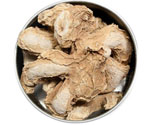
The list of ginger uses is almost endless, being a pungent spicy herb and one of the more popular food spices. They range from baked products like gingerbread, ginger biscuits, and ginger cookies to drinks like ginger tea, ginger beer, ginger ale, etc. Ginger contains about two per cent essential oil. The oil is extracted and distilled from rhizomes for various uses in confectionery, perfumery, beverages and pharmaceuticals.
10 Health Benefits of Dried Ginger
1 - Asthma - It is believed that a mixture of honey and ginger, along with black pepper, is capable of treating or reducing the effects of asthma. It is a naturally soothing and anti-inflammatory mix that releases the tension and promotes the flow of oxygen to the lungs and the relaxation of the blood vessels in the lungs.
2 - Cancer Prevention - Studies have shown that the use of dried ginger result in chemo-preventive properties and the stimulus of antioxidant enzymes that reduce the chances of cancer growth and metastasis. Therefore dried ginger can not only help reduce the symptoms of chemotherapy, but also reduce the chances of getting cancer and needing the treatments in the first place.
3 - Migraine Relief - Dried ginger is reported in Ayurvedic and Tibb systems of medicine to be useful in neurological disorders such as migraines. It is proposed that administration of ginger may exert abortive and prophylactic effects in migraine headaches without any side-effects.
4 - Cold & Flu Prevention - Everyone is aware of the powerful effects that dried ginger has on combating colds and flus. Dried ginger is a potent anti-viral and makes a warming cold and flu remedy. Dried ginger’s active ingredients called gingerols and gingerdiols are effective in reducing some symptoms of viral infections.
5 - Menstrual Cramp Relief - Dried ginger can be used to alleviate menstrual cramping instead of drugs which may pose side effects in the body that are otherwise undesirable.
6 - Diabetic Nephropathy Prevention - Nephropathy (disease of the kidney) is one of the many complications diabetes poses to patients. Dried ginger helps to reduce renal nephropathy.
7 - Heartburn Relief - Dried Ginger, being a natural aid for the gastrointestinal tract, has been used for more than 2000 years in china to treat diarrhea, stomach upset, and heartburn. Dried Ginger is a carminative which is useful when wanting to relieve symptoms of indigestion (aka. heartburn).
8 - Anti-Inflammatory - Ginger has been used as an anti-inflammatory for centuries. The anti-inflammatory compounds called gingerols in dried ginger offer free radical protection by inhibiting the production of nitric oxide which very quickly, under normal conditions, would form damaging free radicals called peroxynitrites.
9 - Improves Immune System - It helps promote regular digestion and metabolism of your food and is largely responsible for promoting a strong immune system.
10 - Aids Weight Loss - Dried ginger is a natural ingredient that’s found in many “fat-burning” supplements. It can speed up the metabolism, leading to calorie-burning. It can also help keep you feeling full for longer, reducing your overall calorie intake.
Producing Countries of Dried Ginger
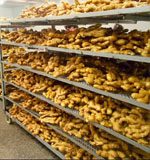
India remains the largest producer, consumer and exporter of this spice, with China close behind, followed by other Asian countries, including Nepal, Japan and Thailand.
The Caribbean islands are also known for their ginger production, especially Jamaica, where the quality of ginger is similar to that of the Indian plant.
South American countries such as Brazil, and African nations like Nigeria and Sierra Leone also cultivate the herb, along with Australia and Fiji, where it is grown on a smaller scale.
Nigeria is the third largest exporter of dried ginger in the world after China and India. Dried Ginger is produced in six states of the Federation namely, Kaduna, Nasarawa, Benue, Niger and Gombe with Kaduna as the major producer. Nigeria produces an average of 40,000 metric tonnes of fresh weight ginger per annum. Out of this production, an average of 10% is locally consumed as fresh ginger while 90% is dried primarily for the export markets.
Consuming Countries of Dried Ginger

Dried Ginger was first exported from Asia in the first century AD along the lucrative Spice Route. Japan is the number one importer of dry ginger. Other major importing countries are United States, United Kingdom, Saudi Arabia, Singapore, Malaysia, Korea, Netherlands, Canada, Germany, and France. Both the Netherlands and Singapore serve as importing countries and re-export to neighboring countries, and other world countries.
Recipe for Beverages with Dried Ginger
Lemon Dried Ginger Iced Green Tea
Ingredients:
A: 2 cups water
B: 1 cup (or to taste) low-calorie sweetener
C: 1 teaspoon ground dried ginger
D: 1 1/2 teaspoons grated lemon peel
E: 4 teaspoons fresh lemon juice
F: 6 green tea bags
A: Add water, low-calorie sweetener, ground dried ginger, and lemon peel to medium saucepan and bring to boil over medium heat. Reduce heat to where it sustains a gentle boil and cook for about 7-8 minutes. Remove from heat and add the green tea bags. Steep this tea mixture for 10 minutes, stirring or dunking the bags often. B: Remove tea bags and stir lemon juice into the tea liquid. Cover and refrigerator for up to 1 to 2 weeks. C: To make a cup of iced tea, pour 1/4 cup of the concentrated tea mixture into a tall glass and stir in 3/4 cup of sparkling or seltzer water or club soda. Add ice cubes and enjoy!
Recipe for Cooking with Dried Ginger
Tofu with Peanut-Dried Ginger Sauce
Ingredients: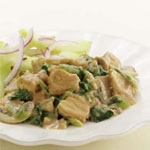
SAUCE A: 5 tablespoons water B: 4 tablespoons smooth natural peanut butter C: 1 tablespoon rice vinegar, (see Ingredient note) or white vinegar D: 2 teaspoons reduced-sodium soy sauce E: 2 teaspoons honey F: 2 teaspoons minced dried ginger G: 2 cloves garlic, minced TOFU & VEGETABLES A: 14 ounces extra-firm tofu, preferably water-packed B: 2 teaspoons extra-virgin olive oil C: 4 cups baby spinach, (6 ounces) D: 1 1/2 cups sliced mushrooms, (4 ounces) E: 4 scallions, sliced (1 cup)
Preparation MethodA: To prepare sauce: Whisk water, peanut butter, rice vinegar (or white vinegar), soy sauce, honey, dried ginger and garlic in a small bowl. B: To prepare tofu: Drain and rinse tofu; pat dry. Slice the block crosswise into eight 1/2-inch-thick slabs. Coarsely crumble each slice into smaller, uneven pieces. C: Heat oil in a large nonstick skillet over high heat. Add tofu and cook in a single layer, without stirring, until the pieces begin to turn golden brown on the bottom, about 5 minutes. Then gently stir and continue cooking, stirring occasionally, until all sides are golden brown, 5 to 7 minutes more. D: Add spinach, mushrooms, scallions and the peanut sauce and cook, stirring, until the vegetables are just cooked, 1 to 2 minutes more.
Recipe for Dessert with Dried Ginger
Eggless Coconut Cookies
Ingredients: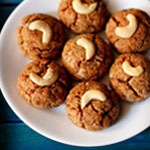
A: 1 cup whole wheat flour/atta, 120 grams B: ¼ cup desiccated coconut C: ¼ tsp baking soda or baking powder D: 4 tbsp coconut oil, you can also use 3 tbsp E: 1 tbsp fine sooji/cream of wheat F: ½ tsp cardamom powder or 4 to 5 green cardamoms, crushed in mortar-pestle G: ¼ tsp dried ginger powder/saunth H: ½ cup organic powdered or grated jaggery/gur, 85 grams I: 2 to 3 tbsp water or coconut milk, add as required
Preparation MethodA: first take 1 cup whole wheat flour, 120 grams and ¼ tsp baking soda in a mixing bowl. B: with a spoon or spatula mix very well. also preheat your oven to 180 degrees celsius/356 degrees fahrenheit. C: add 4 tbsp coconut oil. you can also add 3 tbsp coconut oil. D: lightly mix the oil with the flour. instead of coconut oil, you can also use 4 tbsp butter or ghee. E: then add 1 tbsp fine sooji, ½ tsp cardamom powder and ¼ tsp dried ginger powder. F: add ½ cup powdered or grated jaggery, 85 grams. G: mix everything well with your fingertips. Add 2 to 3 tbsp water. add the water in parts and start mixing with the dough. depending on the type of flour, you may add less or even more water. H: just mix together with your hands and gather to a dough. don't knead. lightly mix and form into a dough ball. I: pinch small to medium sized balls from the dough and place on a greased tray. Press one cashew half or almond on each cookie and slightly flatten them while pressing the cashews. J: bake in the preheated oven at 180 degrees C/356 degrees fahrenheit for 20-25 mins till the tops become light golden. Since oven temperatures vary, it may takes less or more time.

